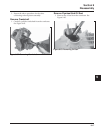
10.1
Section 10
Inspection and Reconditioning
10
Section 10
Inspection and Reconditioning
This section covers the operation, inspection, and
repair/reconditioning of major internal engine
components. The following components are not
covered in this section. They are covered in sections of
their own:
Air Cleaner, Section 4
Carburetor & External Governor, Section 5
Ignition, Charging & Electric Starter, Section 8
Clean all parts thoroughly. Only clean parts can be
accurately inspected and gauged for wear or damage.
There are many commercially available cleaners that
will quickly remove grease, oil, and grime from
engine parts. When such a cleaner is used, follow the
manufacturer’s instructions and safety precautions
carefully. Make sure all traces of the cleaner are
removed before the engine is reassembled and placed
into operation. Even small amounts of these cleaners
can quickly break down the lubricating properties of
engine oil.
Use an aerosol gasket remover, paint stripper, or
lacquer thinner to remove any old sealant. Apply the
solvent, allow time for it to work, and then brush the
surface with a brass wire brush. After the old sealant
is removed, clean the surface with isopropyl alcohol,
lacquer thinner, or aerosol electrical contact cleaner.
Do not scrape the surfaces, as any scratches, nicks, or
burrs can result in leaks. See Service Bulletin 252 for
further information.
Refer to A Guide to Engine Rebuilding (TP-2150-A)
for additional information. Measurement Guide
(TP-2159-B) and Engine Inspection Data Record
(TP-2435) are also available; use these to record
inspection results.
Automatic Compression Release (ACR)
Some engines are equipped with the optional
Automatic Compression Release (ACR) mechanism.
The ACR lowers compression at cranking speeds to
make starting easier.
Operation
The ACR mechanism consists of a flyweight, spring
and pivoting control pin assembly attached to the gear
on the camshaft. At cranking speeds (700 RPM or
lower), the control pin protrudes above the exhaust
cam lobe. This pushes the exhaust valve off its seat
during the first part of the compression stroke. The
reduced compression results in an effective
compression ratio of about 2:1 during cranking.
After starting, engine speed increases to over 700
RPM, and centrifugal force overcomes the force of the
flyweight spring. The flyweight moves outward,
pulling the arm of the control pin, so it pivots into the
‘‘run’’ position. The control pin no longer has any
effect on the exhaust valve and the engine operates at
full power.
When the engine is stopped, the spring returns the
flyweight lever and control pin assembly to the
compression release position ready for the next start.
Camshaft
Inspection and Service
Check the lobes of the camshaft for wear or damage.
See Section 1 for minimum lift specifications. Inspect
the cam gear for badly worn, chipped or missing teeth.
Replacement of the camshaft will be necessary if any
of these conditions exist.
Crankshaft
Inspection and Service
Inspect the gear teeth of the crankshaft. If the teeth are
badly worn, chipped, or some are missing,
replacement of the crankshaft will be necessary.


















